Editors’ Choice: Podcasting Gear, Microphones and More
If you’re looking to start podcasting, or upgrade your podcasting rig, read on for our current recommendations for microphones, preamps, and accessories. We will update this page if we discover anything better than what we’ve listed. As of November, 2012, based on our own tests, these are our current favorites.
Best USB Podcasting Microphone
If you’re just starting out and have no recording equipment at all, we recommend the 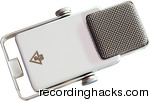 Studio Projects LSM. The mic has both XLR (analog) and USB (digital) outputs, which means you don’t need any other audio gear. Specifically, you don’t need a microphone preamp or a “digital audio interface” or soundcard. Just plug this mic into your computer via USB and you’ll be tracking immediately.
Studio Projects LSM. The mic has both XLR (analog) and USB (digital) outputs, which means you don’t need any other audio gear. Specifically, you don’t need a microphone preamp or a “digital audio interface” or soundcard. Just plug this mic into your computer via USB and you’ll be tracking immediately.
We recommend working the microphone fairly close — within 6 inches. This allows proximity effect (bass boost due to proximity) to compensate for the natural high-frequency lift of the microphone’s capsule. We also recommend using an external pop filter, and further, you might want to position the mic so you’re not blasting straight into it. Condenser mics tend not to like that. Position it off to one side, slightly, or at eye height tilted down.
The LSM is compact, lightweight, and solidly built. It has a built-in desk stand (although when your budget allows, we recommend picking up a boom arm). For more information on the LSM, see our in-depth Best $200 Podcasting Mics review.
If you already have an audio interface or soundcard, see the sections below for appropriate mic recommendations.
Buy the Studio Projects LSM
| Item | Store | Street Price |
| Studio Projects LSM | Front End Audio | $179.99 |
| LSM (black) | Amazon | $674.69 |
Best Audio Interface – Under $150
If you have the budget for an audio interface (soundcard) and a microphone, many more mic choices become available. If you’re starting from scratch and have the budget for more than the cost of the Studio Projects LSM, you’ll need an audio interface with a built-in mic preamp such as one of the two units in this section. Then add any of the mics listed below.
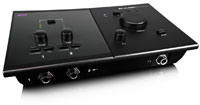 We recommend the M-Audio Fast Track C400. This product might have been recently discontinued due to Avid’s sale of the M-Audio brand, but the device is readily available online for $99-$150, down from $250 when we selected it as one of our favorite budget audio interfaces. It has two mic inputs and a 24-bit converter that sounds great. It also has plenty of gain for dynamic mics, which are in my opinion the best choice for broadcast voice applications. This box was a good deal at $250, and an unbeatable deal at $150.
We recommend the M-Audio Fast Track C400. This product might have been recently discontinued due to Avid’s sale of the M-Audio brand, but the device is readily available online for $99-$150, down from $250 when we selected it as one of our favorite budget audio interfaces. It has two mic inputs and a 24-bit converter that sounds great. It also has plenty of gain for dynamic mics, which are in my opinion the best choice for broadcast voice applications. This box was a good deal at $250, and an unbeatable deal at $150.
Alternatives
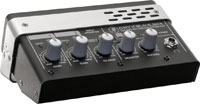 We recommend the Mackie Onyx Blackjack. It has two mic inputs, a 24-bit converter, and a street price of $150. Its build quality is excellent, and it is extremely easy to use. In our interface shootout, it had a slightly higher noise floor than the C400, which makes it somewhat less suitable for use with very low-gain dynamics like the Shure SM7B. For most dynamics, and any condenser mic, the Blackjack will shine.
We recommend the Mackie Onyx Blackjack. It has two mic inputs, a 24-bit converter, and a street price of $150. Its build quality is excellent, and it is extremely easy to use. In our interface shootout, it had a slightly higher noise floor than the C400, which makes it somewhat less suitable for use with very low-gain dynamics like the Shure SM7B. For most dynamics, and any condenser mic, the Blackjack will shine.
Best Podcast Microphone – Under $100
It needs to be said. If you already have an audio interface and mic preamp, you probably also already own what is an excellent podcasting mic: the  Shure SM57. They’re not sexy, but they really work.
Shure SM57. They’re not sexy, but they really work.
You can hear the SM57 in our Ultimate Podcasting Mic Shootout. Use a working distance of 5–8 inches. Because the SM57 has minimal pop protection, it should be mounted off-axis. The SM57 is unfussy, easy to use, consistent, and clear. And after the podcast, you can stick it on a snare drum or guitar cab.
Buy the Shure SM57
| Item | Store | Street Price |
| Shure SM57 | Musician's Friend | $99.00 |
| SM57 | Front End Audio | $99.00 |
(The SM58 is arguably an even better choice, because it has better pop filtering in its ball grille.)
Best Podcast Microphone – Under $150
For a bit more money than the SM57/SM58, we recommend the  Electro-Voice N/D468. I’ve found this to be a wonderfully versatile microphone. On my voice, the sound is clear and nicely detailed. Because it has higher sensitivity than the SM57/SM58, the resulting noise floor is lower. And the yoke-mount design makes positioning a snap.
Electro-Voice N/D468. I’ve found this to be a wonderfully versatile microphone. On my voice, the sound is clear and nicely detailed. Because it has higher sensitivity than the SM57/SM58, the resulting noise floor is lower. And the yoke-mount design makes positioning a snap.
Beyond about 6 inches, this mic might sound thin, especially on higher-pitched or female voices. Worked more close, it sounds very balanced, with a good amount of detail and no obvious coloration.
Buy the Electro-Voice N/D468
Best Podcast Microphone – Under $300
We recommend the  Electro-Voice RE320. It’s a sort of modern take on the venerable RE20, a broadcast standard for many years, and shares that mic’s “variable-D” feature for reducing proximity effect — which means the speaker can move around the mic a bit more without causing so much tonal change. Critically, the RE320 adds a passive EQ switch that cuts the low mids. On male voices, this mode sounds great over a wide range of working distances, say 3–10 inches.
Electro-Voice RE320. It’s a sort of modern take on the venerable RE20, a broadcast standard for many years, and shares that mic’s “variable-D” feature for reducing proximity effect — which means the speaker can move around the mic a bit more without causing so much tonal change. Critically, the RE320 adds a passive EQ switch that cuts the low mids. On male voices, this mode sounds great over a wide range of working distances, say 3–10 inches.
Buy the Electro-Voice RE320
| Item | Store | Street Price |
| RE320 | Front End Audio | $299.00 |
| E-V RE320 | Musician's Friend | $299.00 |
Best Podcast Microphone – Under $350
We recommend the 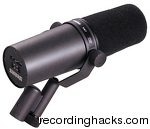 Shure SM7B. This is another broadcast-industry favorite. The yoke mount makes positioning easy. And the mic has the best rear rejection we’ve seen, making it an excellent choice for use in a noisy environment.
Shure SM7B. This is another broadcast-industry favorite. The yoke mount makes positioning easy. And the mic has the best rear rejection we’ve seen, making it an excellent choice for use in a noisy environment.
One word of caution, though — you don’t want to use this mic unless you have a very clean preamp, such as the Fast Track C400 recommended above. For more, see our SM7B/budget audio interface shootout.
Buy the Shure SM7B
| Item | Store | Street Price |
| Shure SM7B | Musician's Friend | $399.00 |
| Shure SM7b | Front End Audio | $399.00 |
| SM7B | Amazon | $399.00 |
Best Podcast Microphone – Under $500
My personal go-to voice mic is the  beyerdynamic M 99. In a blind test of the best radio mics in the world, I picked the M99 as my favorite on my own voice.
beyerdynamic M 99. In a blind test of the best radio mics in the world, I picked the M99 as my favorite on my own voice.
Two onboard passive EQ modes help tune the mic for vocal range and working distance. This means the learning curve is a bit steeper than some of these other mics. Also, the mic has more pronounced proximity effect than the SM7B or RE320, which means it is a bit harder to use. But once you dial it in, it sounds fantastic.
Buy the beyerdynamic M99
| Item | Store | Street Price |
| beyerdynamic M 99 | Front End Audio | $479.99 |
The other choice here at the top of the price spectrum is the  Electro-Voice RE20. This mic won the Readers Poll in the Ultimate Podcasting Mic Shootout, for good reason — it’s a sound you’ve been hearing on the radio your whole life.
Electro-Voice RE20. This mic won the Readers Poll in the Ultimate Podcasting Mic Shootout, for good reason — it’s a sound you’ve been hearing on the radio your whole life.
It is less open on top than newer designs such as the M99 and RE320, but sounds unfailingly warm and authoritative. Its Variable-D design means it is easy to use. If you have the space and budget, you can’t go wrong with an RE20.
Buy the Electro-Voice RE20
| Item | Store | Street Price |
| RE20 | Amazon | $398.99 |
| E-V RE20 | Musician's Friend | $399.99 |
| E-V RE-20 | Pro Audio Solutions | $449.00 |
| Electro-Voice RE20 | Front End Audio | $449.00 |
Accessories
Desktop Boom Arms
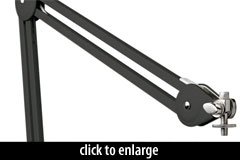 None of the mics listed on this page will sound good if you position them poorly. The best way to put the mic where you need it is with a boom arm. We reviewed many of them in our Microphone Boom Arm Shootout; based on those extensive tests, we recommend the Rode PSA-1 and Heil PL-2T.
None of the mics listed on this page will sound good if you position them poorly. The best way to put the mic where you need it is with a boom arm. We reviewed many of them in our Microphone Boom Arm Shootout; based on those extensive tests, we recommend the Rode PSA-1 and Heil PL-2T.
Pop Filters
 Most of the dynamic mics on this page won’t need a pop filter. If you’re getting plosives in your podcast track, you could first try moving the mic above or off to the side of your mouth. If you still need a pop filter, we recommend the Stedman Proscreen PS-101.
Most of the dynamic mics on this page won’t need a pop filter. If you’re getting plosives in your podcast track, you could first try moving the mic above or off to the side of your mouth. If you still need a pop filter, we recommend the Stedman Proscreen PS-101.